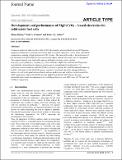Files in this item
Development and performance of MgFeCrO4 – based electrodes for solid oxide fuel cells
Item metadata
| dc.contributor.author | Stefan, Elena | |
| dc.contributor.author | Connor, Paul Alexander | |
| dc.contributor.author | Irvine, John Thomas Sirr | |
| dc.date.accessioned | 2014-06-01T23:01:28Z | |
| dc.date.available | 2014-06-01T23:01:28Z | |
| dc.date.issued | 2013-07-28 | |
| dc.identifier | 56691510 | |
| dc.identifier | 34ced40d-5930-4dd9-959b-bff09ad08116 | |
| dc.identifier | 000320876000023 | |
| dc.identifier | 84879993388 | |
| dc.identifier.citation | Stefan , E , Connor , P A & Irvine , J T S 2013 , ' Development and performance of MgFeCrO 4 – based electrodes for solid oxide fuel cells ' , Journal of Materials Chemistry A , vol. 1 , no. 28 , pp. 8262-8269 . https://doi.org/10.1039/C3TA11496A | en |
| dc.identifier.issn | 2050-7488 | |
| dc.identifier.other | ORCID: /0000-0002-1492-7590/work/60427195 | |
| dc.identifier.other | ORCID: /0000-0002-8394-3359/work/68280652 | |
| dc.identifier.uri | https://hdl.handle.net/10023/4837 | |
| dc.description.abstract | Composite anodes for solid oxide fuel cells (SOFC) developed on yttria stabilised zirconia (YSZ) porous supports by infiltration of electrode materials has been successfully applied for various anode and cathode compositions, resulting in high performance SOFC devices. The focus of this study is the performance of the chromium-rich spinel (MgFeCrO4) as an electrode support material when used alone or impregnated. The composite anodes were prepared by aqueous infiltration of nitrate salts to produce (La0.75Sr0.25)0.97Cr0.5Mn0.5O3−δ, Ce0.9Gd0.1O2−δ, CeO2 or Pd into a MgFeCrO4 scaffold with 45% porosity and studied by electrochemical impedance spectroscopy in symmetrical cell configuration. The performance was evaluated in humidified 5% H2/Ar in order to quantify their stability and performance up to 850 °C with respect to the MgFeCrO4 porous substrate. It was found that all the impregnated phases adhere very well to the spinel and considerably enhance performance and stability to a level required for SOFC applications. MgFeCrO4/LSCM/CGO and MgFeCrO4/LSCM/CGO/Pd showed the most substantial improvement in comparison to the scaffold’s performance, with ASR values of 1.74 Ω cm2 and 0.91 Ω cm2, respectively. | |
| dc.format.extent | 8 | |
| dc.format.extent | 6241616 | |
| dc.language.iso | eng | |
| dc.relation.ispartof | Journal of Materials Chemistry A | en |
| dc.subject | solid oxide fuel cells (SOFC) | en |
| dc.subject | Yttria stabilised zirconia (YSZ) | en |
| dc.subject | Chromium-rich spinel | en |
| dc.subject | Spectroscopy | en |
| dc.subject | Symmetrical cell configuration | en |
| dc.title | Development and performance of MgFeCrO4 – based electrodes for solid oxide fuel cells | en |
| dc.type | Journal article | en |
| dc.contributor.sponsor | European Commission | en |
| dc.contributor.sponsor | Office of Naval Research | en |
| dc.contributor.sponsor | EPSRC | en |
| dc.contributor.institution | University of St Andrews. School of Chemistry | en |
| dc.contributor.institution | University of St Andrews. St Andrews Sustainability Institute | en |
| dc.contributor.institution | University of St Andrews. EaSTCHEM | en |
| dc.identifier.doi | 10.1039/C3TA11496A | |
| dc.description.status | Peer reviewed | en |
| dc.date.embargoedUntil | 2014-06-02 | |
| dc.identifier.grantnumber | en | |
| dc.identifier.grantnumber | N00014-11-1-0247 | en |
| dc.identifier.grantnumber | EP/K015540/1 | en |
This item appears in the following Collection(s)
Items in the St Andrews Research Repository are protected by copyright, with all rights reserved, unless otherwise indicated.

